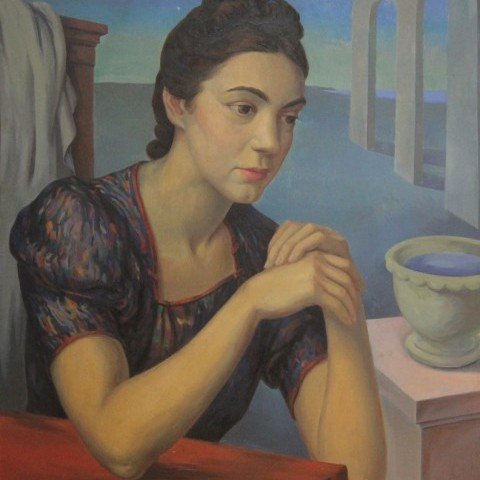Kenneth Stubbs painted in oil and casein and did extensive pen drawing and water color. His interest in tradition, in form and content, and in modern art led him to a painting style concerned with flat or semi-flat patterns, where bright colors and angular, faceted forms combine to give the full work a sense of motion or action. His lifelong fascination with the Golden Section, kindled during his studies with E. Ambrose Webster and intensified during a year abroad, strongly informed his compositions. But his analytical mind, which was so drawn to geometry, chess, and go, also produced lyrical water colors and Japanese brush drawings and his expert draftsman’s hand was also capable of drawings of gentle humor and wit.
Born in Ochlocknee, Georgia, in 1907, Stubbs moved to Washington, D.C. with his family as a young boy. From 1926 to 1930, he studied at the Corcoran School of Art in Washington, D.C. In 1931 and 1934, he studied in Provincetown with E. Ambrose Webster, one of the country’s pioneers in modern art. His major influences were Webster, Piero della Francesca and Juan Gris.
From 1935 to 1953, Stubbs taught painting and drawing at the Corcoran School; he also taught George Washington University art classes from 1941 to 1953, with time out for three years in the Navy during World War II and a year abroad.
From 1930 until his death in October 1967, Stubbs exhibited frequently in the Corcoran Biennial, Society of Washington Artists, and Artists Guild, and in shows of the Provincetown Art Association. He had solo exhibits at the Corcoran, the George Washington University Library, the D.C. Library, and prominent commercial galleries. Memorial exhibitions of his work have been held at the Provincetown Art Association, Hofstra University, the Fine Arts Work Center in Provincetown, and the Cape Cod Museum of Art.
Stubbs’ work is in the permanent collections of the Provincetown Art Association, Cape Cod Museum of Art, National Portrait Gallery, University of Maryland, and Colquitt County Community Art Center (near his Georgia birthplace).
He was one of the Washington area’s leading tournament chess players, found time to illustrate Edward Lasker’s Chess Secrets with sketches of world-renowned chess masters, and was one of the first in the area to become proficient in the game of Go, teaching himself enough Japanese in the 1940s to master the only literature then available on the game.

